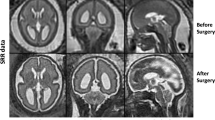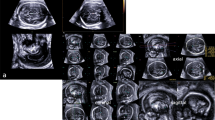Abstract
Introduction
The accurate and precise measurement of brain volumes in young children is important for early identification of children with reduced brain volumes and an increased risk for neurodevelopmental impairment. Brain volumes can be measured from cerebral MRI (cMRI), but most neuroimaging tools used for cerebral segmentation and volumetry were developed for use in adults and have not been validated in infants or young children. Here, we investigate the feasibility and accuracy of three automated software methods (i.e., SPM, FSL, and FreeSurfer) for brain volumetry in young children and compare the measures with corresponding volumes obtained using the Cavalieri method of modern design stereology.
Methods
Cerebral MRI data were collected from 21 children with a complex congenital heart disease (CHD) before Fontan procedure, at a median age of 27 months (range 20.9–42.4 months). Data were segmented with SPM, FSL, and FreeSurfer, and total intracranial volume (ICV) and total brain volume (TBV) were compared with corresponding measures obtained using the Cavalieri method.
Results
Agreement between the estimated brain volumes (ICV and TBV) relative to the gold standard stereological volumes was strongest for FreeSurfer (p < 0.001) and moderate for SPM segment (ICV p = 0.05; TBV p = 0.006). No significant association was evident between ICV and TBV obtained using SPM NewSegment and FSL FAST and the corresponding stereological volumes.
Conclusions
FreeSurfer provides an accurate method for measuring brain volumes in young children, even in the presence of structural brain abnormalities.



Similar content being viewed by others
Abbreviations
- AUC:
-
Area under the curve
- BET:
-
Brain extraction tool
- CE:
-
Coefficient of error
- CHD:
-
Congenital heart disease
- cMRI:
-
Cerebral magnetic resonance imaging
- CSF:
-
Cerebrospinal fluid
- ICV:
-
Intracranial volume
- FAST:
-
FSL segmentation tool
- FSL:
-
FMRIB Software Library v5.0
- GM:
-
Gray matter
- HLHS:
-
Hypoplastic left-heart syndrome
- HLHC:
-
Hypoplastic left-heart complex
- MNI:
-
Montreal Neurological Institute
- MP-RAGE:
-
Magnetization prepared rapid acquisition gradient echo
- MRI:
-
Magnetic resonance imaging
- SPGR:
-
Spoiled gradient echo
- SPM8:
-
Statistical Parametric Mapping version 8
- TBV:
-
Total brain volume
- UVH:
-
Univentricular hypoplasia
- WM:
-
White matter
References
Khalil A, Suff N, Thilaganathan B, Hurrell A, Cooper D, Carvalho JS (2014) Brain abnormalities and neurodevelopmental delay in congenital heart disease: systematic review and meta-analysis. Ultrasound Obstet Gynecol 43:14–24
Owen M, Shevell M, Donofrio M, Majnemer A, McCarter R, Vezina G, Bouyssi-Kobar M, Evangelou I, Freeman D, Weisenfeld N, Limperopoulos C (2014) Brain volume and neurobehavior in newborns with complex congenital heart defects. J Pediatr 164:1121–1127.e1121
Watanabe K, Matsui M, Matsuzawa J, Tanaka C, Noguchi K, Yoshimura N, Hongo K, Ishiguro M, Wanatabe S, Hirono K, Uese K, Ichida F, Origasa H, Nakazawa J, Oshima Y, Miyawaki T, Matsuzaki T, Yagihara T, Bilker W, Gur RC (2009) Impaired neuroanatomic development in infants with congenital heart disease. J Thorac Cardiovasc Surg 137:146–153
von Rhein M, Buchmann A, Hagmann C, Huber R, Klaver P, Knirsch W, Latal B (2014) Brain volumes predict neurodevelopment in adolescents after surgery for congenital heart disease. Brain 137:268–276
Dale AM, Fischl B, Sereno MI (1999) Cortical surface-based analysis. I. Segmentation and surface reconstruction. Neuroimage 9:179–194
Fischl B, Salat DH, Busa E, Albert M, Dieterich M, Haselgrove C, van der Kouwe A, Killiany R, Kennedy D, Klaveness S, Montillo A, Makris N, Rosen B, Dale AM (2002) Whole brain segmentation: automated labeling of neuroanatomical structures in the human brain. Neuron 33:341–355
Smith SM, Jenkinson M, Woolrich MW, Beckmann CF, Behrens TE, Johansen-Berg H, Bannister PR, De Luca M, Drobnjak I, Flitney DE, Niazy RK, Saunders J, Vickers J, Zhang Y, De Stefano N, Brady JM, Matthews PM (2004) Advances in functional and structural MR image analysis and implementation as FSL. Neuroimage 23(Suppl 1):S208–S219
Ashburner J, Friston KJ (1999) Nonlinear spatial normalization using basis functions. Hum Brain Mapp 7:254–266
Gousias IS, Rueckert D, Heckemann RA, Dyet LE, Boardman JP, Edwards AD, Hammers A (2008) Automatic segmentation of brain MRIs of 2-year-olds into 83 regions of interest. Neuroimage 40:672–684
Murgasova M, Dyet L, Edwards D, Rutherford M, Hajnal J, Rueckert D (2007) Segmentation of brain MRI in young children. Acad Radiol 14:1350–1366
Heckemann RA, Hajnal JV, Aljabar P, Rueckert D, Hammers A (2006) Automatic anatomical brain MRI segmentation combining label propagation and decision fusion. Neuroimage 33:115–126
McQuillen PS, Miller SP (2010) Congenital heart disease and brain development. Ann N Y Acad Sci 1184:68–86
Bartholomeusz HH, Courchesne E, Karns CM (2002) Relationship between head circumference and brain volume in healthy normal toddlers, children, and adults. Neuropediatrics 33:239–241
Ashburner J, Friston K (1997) Multimodal image coregistration and partitioning--a unified framework. Neuroimage 6:209–217
Ashburner J, Friston KJ (2005) Unified segmentation. Neuroimage 26:839–851
Mazziotta J, Toga A, Evans A, Fox P, Lancaster J, Zilles K, Woods R, Paus T, Simpson G, Pike B, Holmes C, Collins L, Thompson P, MacDonald D, Iacoboni M, Schormann T, Amunts K, Palomero-Gallagher N, Geyer S, Parsons L, Narr K, Kabani N, Le Goualher G, Boomsma D, Cannon T, Kawashima R, Mazoyer B (2001) A probabilistic atlas and reference system for the human brain: International Consortium for Brain Mapping (ICBM). Philos Trans R Soc Lond B Biol Sci 356:1293–1322
AC E (1993) 3D statistical neuroanatomical models from 305 MRI volumes. In: DL C (ed). Proc. IEEE Nucl. Sci. Symp. Med. Imaging Conf., pp 1813–1817.
Shi F, Yap PT, Wu G, Jia H, Gilmore JH, Lin W, Shen D (2011) Infant brain atlases from neonates to 1- and 2-year-olds. PLoS One 6:e18746
Zhang Y, Brady M, Smith S (2001) Segmentation of brain MR images through a hidden Markov random field model and the expectation-maximization algorithm. IEEE Trans Med Imaging 20:45–57
Desikan RS, Ségonne F, Fischl B, Quinn BT, Dickerson BC, Blacker D, Buckner RL, Dale AM, Maguire RP, Hyman BT, Albert MS, Killiany RJ (2006) An automated labeling system for subdividing the human cerebral cortex on MRI scans into gyral based regions of interest. Neuroimage 31:968–980
Fischl B, Sereno MI, Dale AM (1999) Cortical surface-based analysis. II: inflation, flattening, and a surface-based coordinate system. Neuroimage 9:195–207
Fischl B, van der Kouwe A, Destrieux C, Halgren E, Ségonne F, Salat DH, Busa E, Seidman LJ, Goldstein J, Kennedy D, Caviness V, Makris N, Rosen B, Dale AM (2004) Automatically parcellating the human cerebral cortex. Cereb Cortex 14:11–22
Ségonne F, Pacheco J, Fischl B (2007) Geometrically accurate topology-correction of cortical surfaces using nonseparating loops. IEEE Trans Med Imaging 26:518–529
Sled JG, Zijdenbos AP, Evans AC (1998) A nonparametric method for automatic correction of intensity nonuniformity in MRI data. IEEE Trans Med Imaging 17:87–97
Lowe JR, Maclean PC, Caprihan A, Ohls RK, Qualls C, Vanmeter J, Phillips JP (2012) Comparison of cerebral volume in children aged 18–22 and 36–47 months born preterm and term. J Child Neurol 27:172–177
Roberts N, Puddephat MJ, McNulty V (2000) The benefit of stereology for quantitative radiology. Br J Radiol 73:679–697
Puddephat MJ (1999) Computer interface for convenient application for stereological methods for unbiased estimation of volume and surface area: studies using MRI with particular reference to the human brain. University of Liverpool, Liverpool
Keller SS, Highley JR, Garcia-Finana M, Sluming V, Rezaie R, Roberts N (2007) Sulcal variability, stereological measurement and asymmetry of Broca’s area on MR images. J Anat 211:534–555
Keller SS, Gerdes JS, Mohammadi S, Kellinghaus C, Kugel H, Deppe K, Ringelstein EB, Evers S, Schwindt W, Deppe M (2012) Volume estimation of the thalamus using freesurfer and stereology: consistency between methods. Neuroinformatics 10:341–350
Cruz-Orive LM, Gelšvartas J, Roberts N (2014) Sampling theory and automated simulations for vertical sections, applied to human brain. J Microsc 253:119–150
Mayhew TM, Olsen DR (1991) Magnetic resonance imaging (MRI) and model-free estimates of brain volume determined using the Cavalieri principle. J Anat 178:133–144
Keller SS, Roberts N (2009) Measurement of brain volume using MRI: software, techniques, choices and prerequisites. J Anthropol Sci 87:127–151
Salmenperä T, Könönen M, Roberts N, Vanninen R, Pitkänen A, Kälviäinen R (2005) Hippocampal damage in newly diagnosed focal epilepsy: a prospective MRI study. Neurology 64:62–68
Mulder ER, de Jong RA, Knol DL, van Schijndel RA, Cover KS, Visser PJ, Barkhof F, Vrenken H, Initiative ADN (2014) Hippocampal volume change measurement: quantitative assessment of the reproducibility of expert manual outlining and the automated methods FreeSurfer and FIRST. Neuroimage 92:169–181
Eggert LD, Sommer J, Jansen A, Kircher T, Konrad C (2012) Accuracy and reliability of automated gray matter segmentation pathways on real and simulated structural magnetic resonance images of the human brain. PLoS One 7:e45081
Morey RA, Petty CM, Xu Y, Hayes JP, Wagner HR, Lewis DV, LaBar KS, Styner M, McCarthy G (2009) A comparison of automated segmentation and manual tracing for quantifying hippocampal and amygdala volumes. Neuroimage 45:855–866
Klauschen F, Goldman A, Barra V, Meyer-Lindenberg A, Lundervold A (2009) Evaluation of automated brain MR image segmentation and volumetry methods. Hum Brain Mapp 30:1310–1327
Dewey J, Hana G, Russell T, Price J, McCaffrey D, Harezlak J, Sem E, Anyanwu JC, Guttmann CR, Navia B, Cohen R, Tate DF, Consortium HN (2010) Reliability and validity of MRI-based automated volumetry software relative to auto-assisted manual measurement of subcortical structures in HIV-infected patients from a multisite study. Neuroimage 51:1334–1344
Furlong C, García-Fiñana M, Puddephat M, Anderson A, Fabricius K, Eriksen N, Pakkenberg B, Roberts N (2013) Application of stereological methods to estimate post-mortem brain surface area using 3T MRI. Magn Reson Imaging 31:456–465
Medoff-Cooper B, Irving SY, Hanlon AL, Golfenshtein N, Radcliffe J, Stallings VA, Marino BS, Ravishankar C (2016) The association among feeding mode, growth, and developmental outcomes in infants with complex congenital heart disease at 6 and 12 months of Age. J Pediatr 169:154–159.e151
Daymont C, Neal A, Prosnitz A, Cohen MS (2013) Growth in children with congenital heart disease. Pediatrics 131:e236–e242
Acknowledgments
The authors would like to acknowledge the kind assistance of Kaiming Yin in preparing Figure 1, and to thank all study participants and their families. Special thanks go to the MRI staff, the anaesthesiologists and the technical support during data acquisition: Ali Rad, Hadwig Speckbacher, Leila Thalparpan-Pajunen, Martina Boller, Agata Aquino, Steffen Bollmann, Carmen Ghisleni, Ursina McCaskey and Gabriela Staub. Grant support provided by Fördergemeinschaft Deutsche Kinderherzzentren e.V., Bonn, Germany, and the Mäxi Foundation, Zurich, Switzerland.
Author information
Authors and Affiliations
Corresponding author
Ethics declarations
We declare that all human studies have been approved by the local ethics committees of the Canton of Zurich and the University of Giessen, respectively, and have therefore been performed in accordance with the ethical standards laid down in the 1964 Declaration of Helsinki and its later amendments. We declare that all patients gave informed consent prior to inclusion in this study.
Conflict of interest
We declare that we have no conflict of interest.
Rights and permissions
About this article
Cite this article
Mayer, K.N., Latal, B., Knirsch, W. et al. Comparison of automated brain volumetry methods with stereology in children aged 2 to 3 years. Neuroradiology 58, 901–910 (2016). https://doi.org/10.1007/s00234-016-1714-x
Received:
Accepted:
Published:
Issue Date:
DOI: https://doi.org/10.1007/s00234-016-1714-x




